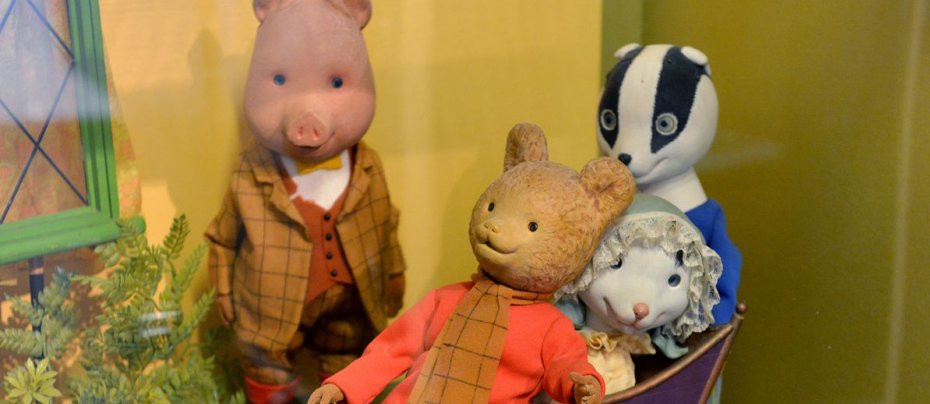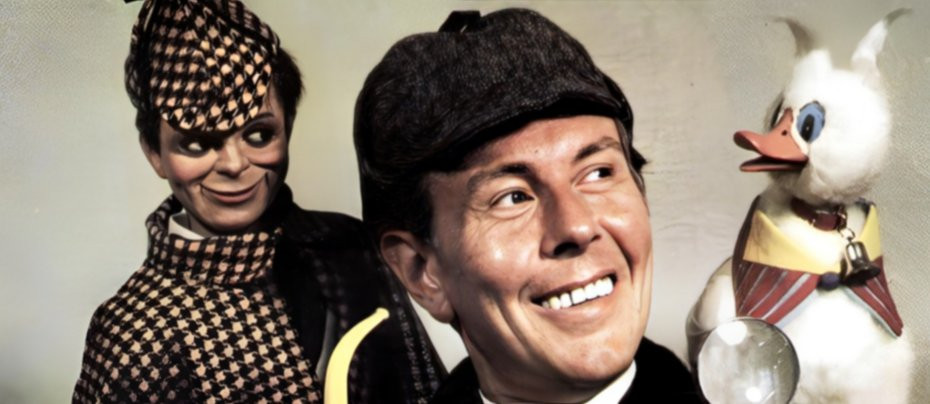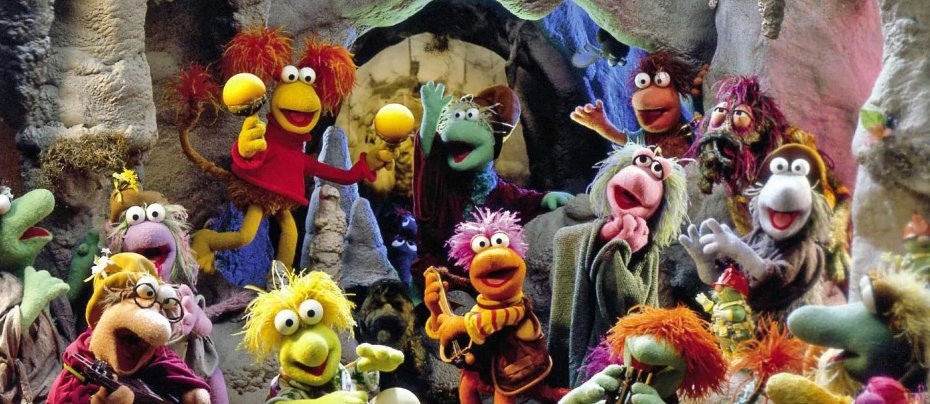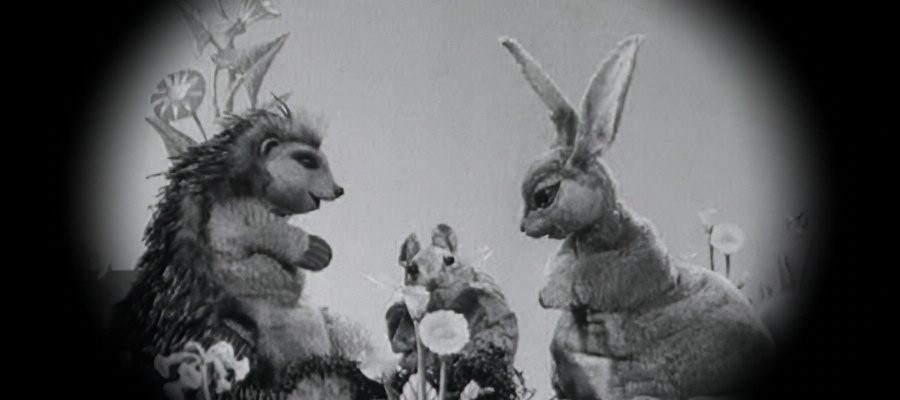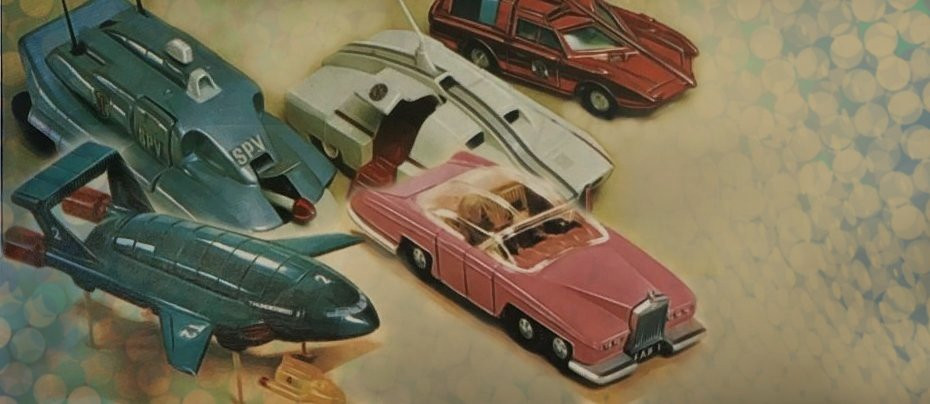
F.A.B. to S.I.G. (The Anderson Die Cast Toys)
F.A.B.
Television toy merchandise, which didn't exist in the UK until the 1950s, now makes a considerable contribution to the children's toys industry which is worth an estimate £16 billion. The rapid rise of TV-tie-in toys demonstrated how the industry quickly responded to a change in the cultural landscape once television became established. As the new medium grew in popularity, so did the manufacturing of toys based on popular TV shows and characters.
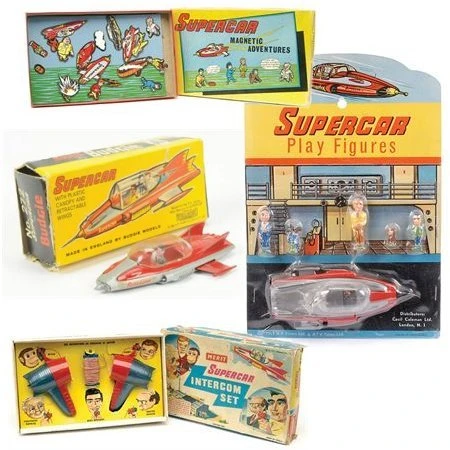
When Supercar arrived on British TV screens in 1961 it captured the imagination of its young audience like no other series before it. Before you could mutter the word 'merchandise' there were wooden puppets of most of the characters, plastic figures, a 'Supercar Magnetic Adventures' board, a Supercar Intercom Set, a large friction model of the craft and, most famous of all among collectors, a Budgie diecast model of Supercar. It was during the production of Supercar that Anderson set up AP Films (Merchandising) Ltd, a separate company set up to handle the licensing of merchandising rights in order to cash in on his product. Within three years AP Merchandising could boast retail sales exceeding £750,000.
Some of the most popular toys of the late 1960s and early 1970s were the vehicles produced by the Meccano Dinky company in the UK in conjunction with Gerry Anderson's most popular series, Thunderbirds and Captain Scarlet and the Mysterons.
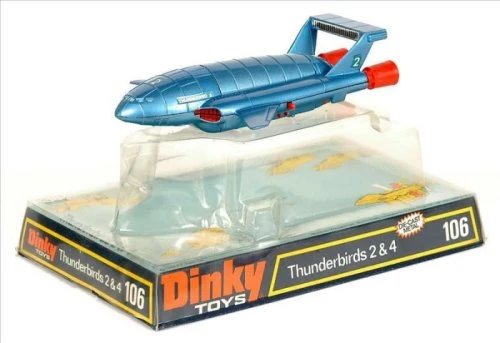
In the beginning there was Thunderbird 2, the gargantuan transport vehicle used by International Rescue. TB2 was originally produced by Dinky in the mid-sixties, and in its correct colour of green, although the pigment was a bit on the dark side, almost a British racing green. The model was entirely made from die-cast metal with spring loaded retractable legs. Unlike later versions of the aircraft, these legs were made of very thin and very brittle plastic. TB2's pod was detachable and came complete with a plastic Thunderbird 4 inside. This version of TB2 was not sold in vast quantities, coupled with the fragile nature of the support legs, good examples of this model are few and far between (I've only ever seen one).
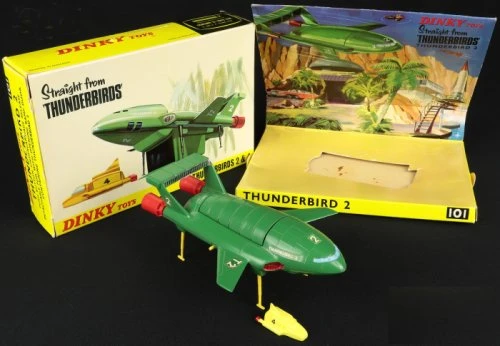
Not wanting to waste a good merchandising opportunity, Dinky went back to the drawing board and a few years later produced a larger version of Thunderbird 2. As with quite a few Dinky TV & Film related toys they neglected to ask anyone what colour TB2 was and produced the toy in a variety of liveries. This version of TB2 was not entirely made from die-cast metal, the upper section of the fuselage was metal with the lower section being made from plastic. These upper and lower sections of fuselage varied in colour, with the most popular combinations being a metallic blue top section with either a white or black plastic bottom section. This TB2 also came with a detachable pod and a plastic TB4 inside.
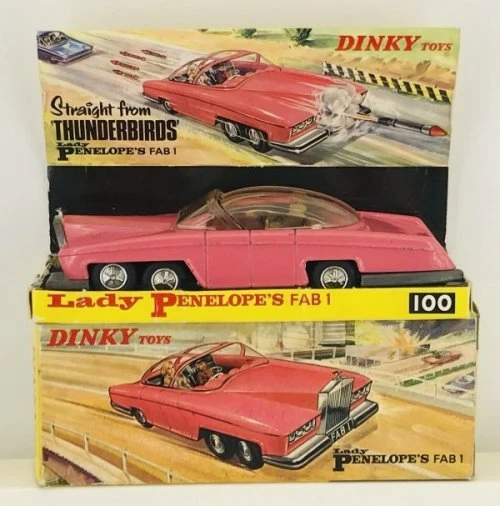
Next on the Dinky production line was FAB1, Lady Penelope's six wheeled pink Rolls Royce. FAB1 was made in approximately 1:32 scale and featured moulded figures of both Parker and Lady Penelope under the huge clear plastic slide back roof canopy. This time Dinky got the colour right and produced the car with a beautiful pink die cast body, although some versions were produced in an almost fluorescent "shocking" pink, these are not as easy to come by as the normal colour. FAB1 came with real jewelled diamante headlamps and included an array of weapons. The famous front grille pulled down revealing a huge spring-loaded missile which could be fired by pushing down on the front of the car (the front axle was part of the spring-loaded mechanism), and four sleek looking red plastic missiles could be fired from four small holes in the back of the car by pushing down on the boot/trunk (the back axle acting the same way as the front). FAB1 became the ultimate addition to any toy collection and soon became Dinky's biggest selling diecast. Originally selling at a hefty 99p, Lady Penelope's car would now cost you in the region of £100 - £200 depending on condition, box, missiles, etc. Trivia Question: What was FAB2? (Answer at the bottom of the page).
That was it. Of the five Thunderbirds only one was produced, there was also no sign of the many varied vehicles carried by TB2, the Mole, Firefly, etc. Children (and grownups) had to wait over twenty-five years for the next Thunderbirds die-cast to surface.
In the early 1990s the BBC was gearing up for a re-launch of this classic 1960s television series. Although merchandising was thin on the ground when Thunderbirds first hit our TV screens, a lot had happened in the two and a half decades that had followed: no popular children's TV series or film was complete without a flood of merchandising hitting the shops.
This time the honour of producing the toys fell to Matchbox, Dinky's 1970s rivals. Not content with just rehashing what Dinky had done twenty-five years before, Matchbox opted for a larger fleet from the Thunderbirds range. They produced a TB2, which was almost exactly the same size as the second version Dinky toy, but this time in the correct colour and glazed transfers had replaced the old paper stickers on its fuselage. As before, TB2 had extendable legs and a detachable pod, but this time TB4 was made from die-cast metal and much more detailed than its predecessor. Not dismissing the popularity of the original FAB1, Matchbox produced one of these too, but this time it was slightly more to scale with TB2, measuring only about two inches in length. The Matchbox FAB1 had no features, it was just a six wheeled car with a moulded plastic interior and no figures inside. The roof of the car was again correctly moulded in clear plastic but did not slide back like the original and was (for my liking) slightly too "domed", standing higher than the actual TV version.
Matchbox also produced a die cast TB1 and a TB3 in scale with TB2. These two vehicles were about the same size as each other and TB1 had retractable wings. Both were moulded in the right colours with the correct livery on them, but for some reason (probably cost), TB1's plastic wings were moulded in blue the same as the engine section instead of light grey. To complete the set, Matchbox produced a version of The Mole, the huge drilling vehicle carried in one of TB2's pods. Although very accurate and including a rotating drill, the mole was not in scale with the rest of the vehicles measuring about five inches long.

All five vehicles were available individually on carded bubble packs, or as a complete set (excluding the Mole). This set, known as the "Rescue Pack" became the must have toy for Christmas 1991. The ultimate accessory for these vehicles came in the form of a huge Tracy Island, which had launch bays for TB1 (complete with sliding swimming pool), TB2 (complete with falling cliff face and moving palm trees), and TB3.
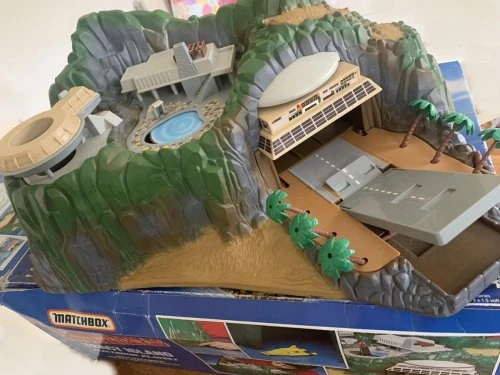
Then, thirty-five years after it was made, Thunderbirds was once again on our screens, digitally remastered in all its glory. Again the fleet was been released in our toyshops, but this time you could get them all. Five Thunderbirds vehicles and FAB1 were now available, produced by a company called Vivid Imaginations, and again TB2 became the most sought after toy over Christmas 2000, this time with its pod holding TB4 and the Mole. This new fleet again came with a Tracy Island, but this time it came with lights and sounds. In fact the five Thunderbird craft and FAB1 also have sounds, each producing a variety of commands in the respective pilots voice at the touch of a button. This set must then surely be the ultimate Thunderbirds vehicle range, all singing, all dancing, all the right colours.
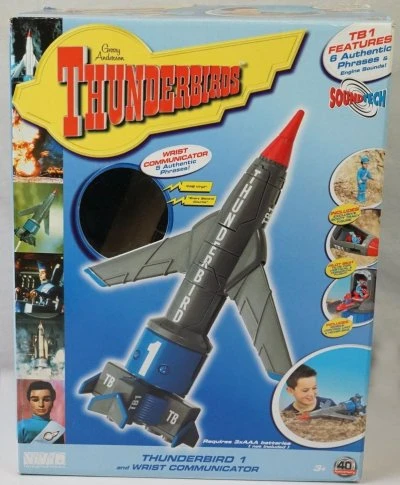
But wait !!! ... They're plastic! Geoff Tracy would never have allowed it in his day.
S.I.G.
Following the huge success of Dinky's Thunderbird 2 and FAB 1 models the company were not about to pass up another opportunity for a winner when Gerry Anderson's next Supermarionation series hit Britain's TV screens. Set in 2068, Captain Scarlet centred around a group of agents that belonged to the Spectrum organisation, and who took their names from colours. Apart from Colonel White, and Lieutenant Green the remainder of the agents were all Captains, the most severe case of too many chiefs I have ever seen. At the disposal of the Spectrum agents was a variety of aircraft including the Angel Interceptors, Spectrum jets, Spectrum helicopters and Cloudbase, the organisations floating HQ in the sky. Trivia Question: What were the real names of the Spectrum agents? (Not just Scarlet and Blue, the others too, including the Angels).
Dinky ignored these aircraft and instead set their sights firmly on the three star vehicles from the series: The SPC (Spectrum Patrol Car), the MSV (Maximum Security Vehicle), and the SPV (Spectrum Pursuit Vehicle). The SPV and MSV were made to the same scale as each other, but the SPC was a much smaller scale making it similar in size to its two Spectrum counterparts.
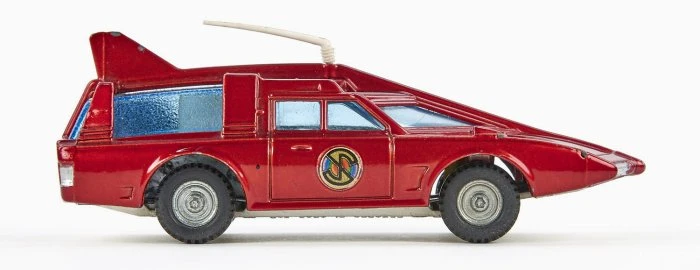
The Spectrum Patrol Car (or Spectrum Saloon Car as it was sometimes known), was the first Captain Scarlet vehicle to be produced by the company and took the Dinky serial number 103. The car was one of Dinky's first to feature a clockwork "pull-back" motor. Most of the SPCs produced were moulded in metallic red as per the car featured in the series with Spectrum logos on each of the two doors, but there are a few in circulation that were produced in a metallic bronze colour. Apart from the pull-back motor, the SPC model has no other working features.
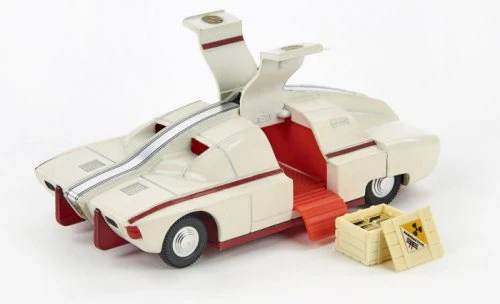
Next was the Spectrum Pursuit Vehicle. No, we'll skip that for now and look at the Maximum Security Vehicle which carried the Dinky serial number 105. This vehicle was probably impossible to turn over when being driven. It had a massive wheel-base and the bodywork was very low to the ground. The MSV was produced in pearl-white die cast with a red die cast base, a metallic silver stripe running the full length of the vehicle from front to back along the middle and Spectrum logos on the doors. The actual MSV from the series was a dull stainless-steel colour not unlike the DeLorean car. Dinky's MSV had opening gull-wing doors which in turn had plastic ramps that were lowered from the floor-pan for access. Inside the vehicle was a removable plastic box moulded to look like a wooden crate with a "radioactive" sticker on the lid. The lid was removable to reveal a cargo of what looked like gold bullion inside. Apart from minor variations like the colour of the interior plastic floor-pan (most were moulded in red, but there are some light blue ones about), there were no major colour changes to the MSVs produced by Dinky.
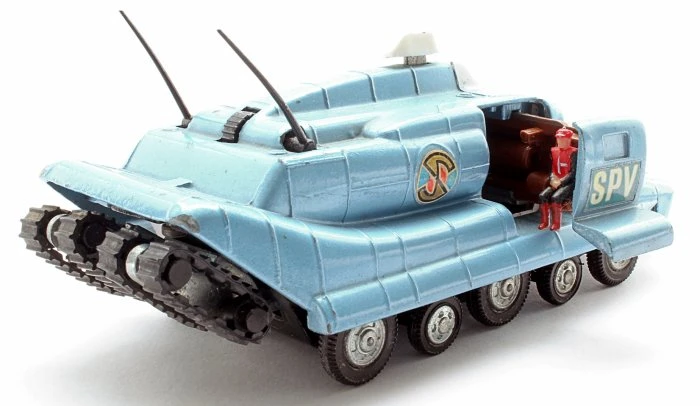
Lastly in the Dinky series of Captain Scarlet vehicles was the Spectrum Pursuit Vehicle carrying the serial number 104. This was a beauty in terms of toy-cars, the massive ten-wheeled behemoth featured almost as many gadgets and working parts as the ever-popular original Corgi James Bond Aston Martin DB5. Firstly, there was the driver's door which sprung open at speed when the small white plastic fin on the roof was pressed. As all Captain Scarlet aficionados are aware, the driver sat with his back to the front of the SPV and relied on a CCTV image of the road ahead to manoeuvre the enormous vehicle along winding country lanes (eek!). True to the series' SPV, Dinky's driver sat the wrong way round. Two versions of the opening door exist, the original models had a Captain Scarlet figure whose seat automatically dropped down on a small plastic hinge so that he was nearer the ground. This however, must have ended in countless accidents when children slammed the door shut without putting the figure and his seat back into the up position first, snapping it clean away from the door.
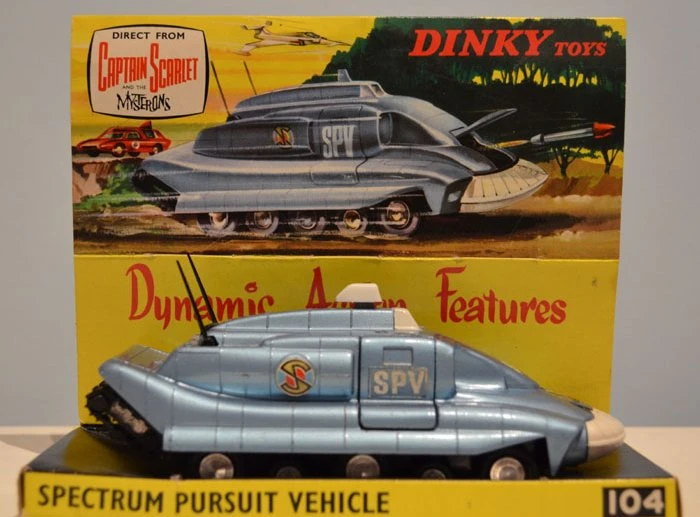
Later Dinky SPVs featured the same Captain Scarlet figure in his seat, but this time firmly fixed to the upright interior section of the door - no more decapitations. The SPV also featured an opening bonnet which revealed a firing missile inside. The firing mechanism was similar to that of FAB1, press the front set of wheels up to open the bonnet, then the second set to fire the missile. The vehicle also had two rotating rear antenna and two sets of eight caterpillar tracked wheels at the back which sprung down for extra stability in treacherous weather conditions. Dinky's SPV was produced in the correct colour of metallic sky-blue with a huge white rubber front bumper, but lacked the smaller colour details of the series' vehicle, like the red piping along the roof and bonnet and the black lines on the bumper. Spectrum logos and stickers with the letters SPV in white appeared on the bonnet and sides of the vehicle. This was the toy to have in the early 1970s, and the SPV became Dinky's best ever selling car - taking the crown from Lady Penelope's FAB1 Rolls Royce.
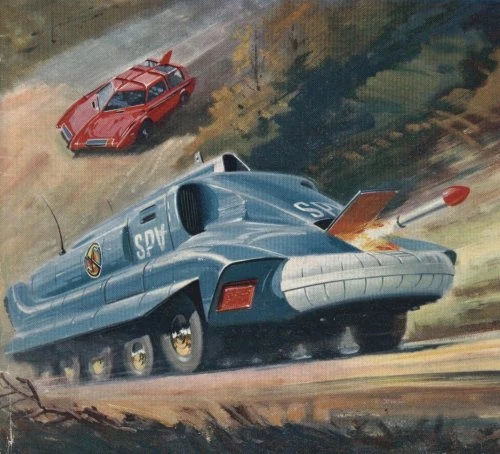
Like Thunderbirds, we had to wait almost a quarter of a century before any new Captain Scarlet die-cast toys went on sale in the UK. Hot on the heels of Thunderbirds, Captain Scarlet was resurrected to a brand-new audience in the early 1990's. This time the diecasts were produced by a company by the name of "Vivid Imaginations", and they lived up to their name. Opting this time round not to just re-release everything that Dinky had made some twenty-five years earlier, but to bring new vehicles to the range.
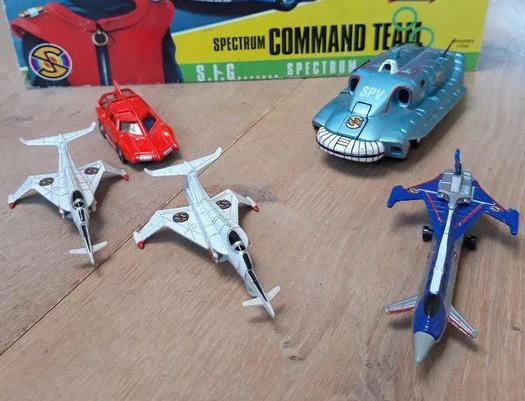
Vivid Imaginations produced an SPV which featured all the same working parts as the original Dinky. The only differences were that the new SPV was slightly smaller than the original with a plastic base and featured the red piping on the roof and bonnet and black lines on the white front bumper that the Dinky toy lacked. Also produced was a SPC made to the same scale as the SPV, being the same scale meant that the new SPC was about the size of a Corgi Junior. The SPC did not have a pull-back motor but did feature an opening boot section revealing a plastic moulded engine inside. To complete the collection, Vivid Imaginations produced the Angel Interceptor (sold in packs of two) and the Spectrum Passenger Jet. All four vehicles were sold on carded blister packs and were also available as a boxed set containing all five (two Angel Interceptors). No MSV was made by Vivid Imaginations.
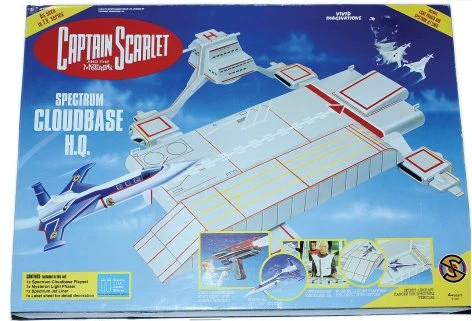
Similarly to Thunderbirds, the new vehicles had the ultimate accessory: a huge plastic "lights & sound" Cloudbase which came complete with a Mysteron voice distorter which doubled as a torch and shone two Mysteron rings - excellent.
So which was best?
A matter of choice I suppose. The originals give way to accuracy, scale and range. But for me the Dinkys win hands down, because they were the originals, they hit the shops at the same time as the series was being first shown on TV in the UK. Sorry Vivid Imaginations but you cannot duplicate a childhood memory that is so. . . . . . . . . . . . well, "vivid".
Trivia Answers: FAB2 was Lady Penelope's yacht.
Here is the list of Spectrum personnel's real names as well as their dates and places of birth. I hardly need tell you that this is classified information:
| Spectrum Agent | Real Name | Date of Birth | Birthplace |
| Colonel White | Charles Gray | 14/07/2017 | London, England |
| Lt. Green | Seymour Griffiths | 18/01/2041 | Trinidad, West Indies |
| Captain Scarlet | Paul Metcalfe | 17/12/2036 | Winchester, England |
| Captain Blue | Adam Svenson | 26/08/2035 | Boston, USA |
| Captain Ochre | Richard Fraser | 23/02/2035 | Detroit, USA |
| Captain Grey | Bradley Holden | 04/03/2033 | Chicago, USA |
| Captain Magenta | Patrick Donaghue | 17/04/2034 | Dublin Bay, Ireland |
| Doctor Fawn | Edward Wilkie | 10/07/2031 | Yalumba, Australia |
| Captain Black | Conrad Turner | 17/03/2029 | Manchester, England |
| Captain Brown | Details unknown | Killed in SPC accident | |
| Captain Indigo | Details unknown | ||
| Destiny Angel | Juliette Pontoin | 23/08/2040 | Paris, France |
| Symphony Angel | Karen Wainwright | 06/01/2042 | Iowa, USA |
| Rhapsody Angel | Dianne Simms | 27/04/2043 | London, England |
| Harmony Angel | Chan Kwan | 10/01/2043 | Atlanta, USA |
Published on December 29th, 2021. Written by Paul Webb for Television Heaven.



